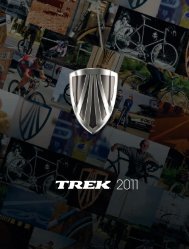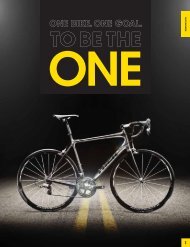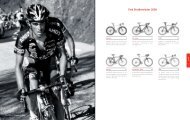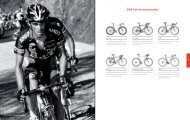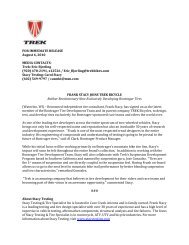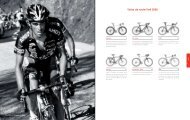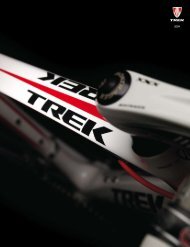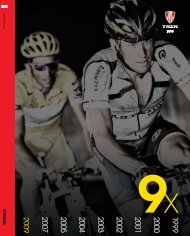Airfoil Development for the Trek Speed Concept ... - Slowtwitch.com
Airfoil Development for the Trek Speed Concept ... - Slowtwitch.com
Airfoil Development for the Trek Speed Concept ... - Slowtwitch.com
You also want an ePaper? Increase the reach of your titles
YUMPU automatically turns print PDFs into web optimized ePapers that Google loves.
The effect of misalignment of <strong>the</strong> #3 KVF trial from Figure 6 is shown in <strong>the</strong> figure below. This data proves that any misalignment will<br />
increase drag, but beyond 12.5˚ <strong>the</strong> drag penalty is particularly severe. For <strong>the</strong>se reasons, <strong>the</strong> <strong>Speed</strong> <strong>Concept</strong> handlebar is designed to<br />
eliminate <strong>the</strong> possibility of misalignment.<br />
Figure 27: Percentage<br />
drag increase due to airfoil<br />
misalignment to <strong>the</strong> bike-axis.<br />
4 <strong>Trek</strong>’s Wind Tunnel Test Standards<br />
To make <strong>the</strong> most precise and objective wind tunnel measurements possible, <strong>Trek</strong> engineers strictly adhere to a set of best practices<br />
developed over <strong>Trek</strong>’s 11 years of wind tunnel testing. Primarily, in each head to head test, every possible aspect of each bike is kept<br />
<strong>the</strong> same. This includes all non-proprietary <strong>com</strong>ponents (wheels, tires, handlebar, shift/brake levers, stem, saddle, brakes, derailleurs,<br />
crank, cassette, etc.) and all adjustments (saddle height, saddle setback, saddle angle, handlebar location, handlebar angle, cable<br />
routing, etc.). Bicycles are tested with manufacturer’s proprietary <strong>com</strong>ponents (integrated cranks, brakes, handlebars, waterbottles,<br />
stems, seatposts, etc.) where standard <strong>com</strong>ponents can not be installed without modification. In addition, <strong>Trek</strong> will only put headto-head<br />
bike data on <strong>the</strong> same plot if it was collected in <strong>the</strong> same test session. Due to increased uncertainty, data is not necessarily<br />
<strong>com</strong>parable from one test session to <strong>the</strong> next. Instead of using old data, <strong>Trek</strong> spends <strong>the</strong> extra time and money to repeat tests and<br />
ensure <strong>com</strong>parable data. Finally, <strong>the</strong>re are safeguards built into <strong>Trek</strong>’s test procedure to ensure reliable, consistent results. Below is<br />
an example image of <strong>the</strong> standard bike setup from <strong>the</strong> June 2009 head-to-head wind tunnel tests including <strong>the</strong> team <strong>Speed</strong> <strong>Concept</strong>.<br />
23<br />
Figure 28: General setup from <strong>the</strong> June 2009 head-to-head<br />
wind tunnel tests. Notes: Team <strong>Speed</strong> <strong>Concept</strong> shown. Wheels<br />
would be spinning during <strong>the</strong> actual test. Bicycle yaw rotation is<br />
counterclockwise, such that <strong>the</strong> wind hits <strong>the</strong> drive side of <strong>the</strong><br />
bicycle. San Diego Low <strong>Speed</strong> Wind Tunnel.




